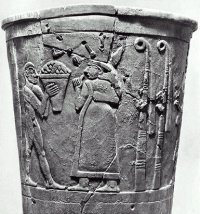Saturday, June 14, 2003
In our No Rest for The Weary Department this morning’s Washington Post takes another at bat with the Iraq Museum pitch.

Iruk Vase, detail
The result is a story that is still defensive and coy when it navigates around press errors of fact, unbelievably, still fails to grasp the priceless nature of the missing artifacts on the Middle Eastern antiquities art market and is filled with unsupported assurances:
The losses turned out to be not nearly as widespread as feared. Reports published around the world that 170,000 items were missing -- the sum of the museum's entire collection -- were vastly inaccurate…When the inventory was calculated this week, a total of 33 of the museum's 8,000 most precious vases, statues and jewels were actually gone. Two underground vaults beneath the Central Bank of Iraq were discovered to contain many of the collection's priceless pieces…
It should be noted that the fears referred to here were expressed in those same reports now described as “vastly inaccurate”. Inaccurate reports that none-the-less consistently quote Donny George, director of Iraq's State Board of Antiquities as claiming 33 or so rapidly stolen priceless items all along. Today’s report continues to incorrectly imply that the artifacts removed from under the Iraq Central Bank were thought to have been missing. A reader of May 6th New York Times would know that:
A top British Museum official said yesterday that his Iraqi counterparts told him they had largely emptied display cases at the National Museum in Baghdad months before the start of the Iraq war, storing many of the museum's most precious artifacts in secure "repositories"…The official, John E. Curtis, curator of the Near East Collection at the British Museum, said he believed that American authorities now knew the locations of the artifact repositories…
The primary source for today’s story is identified only as “Coalition spokeswoman Naheed Mehta”. She repeats yesterday’s coincidental return story:
“They said they had some artifacts they wanted to give back. It just so happened that Pietro Cordone was visiting the museum -- he doesn't go every day -- and they handed it to him. He thanked them for it”…"We didn't interrogate them," she said. "We usually don't."
A story in the June 9th edition of the Washington Post said that the Iruk or Warka Vase:
…Had been bolted to a podium… but looters breached the glass case and ripped the vase from its base.
In today’s report Ms. Mehta describes a scene that make the June 9th description “vastly inaccurate”:
She said the vase had been taken not, as previously reported, from its glass case in an exhibition room, but from a restoration room in the back of the museum where experts were working on the piece. "It had been broken in half in antiquity, and had been repaired in the past . . . It was brought back in exactly the same condition it left the museum. It hadn't suffered any more damage," she said.
And, that’s the way it is…ahem…well, at least for now anyway.
Photo: Washington Post

